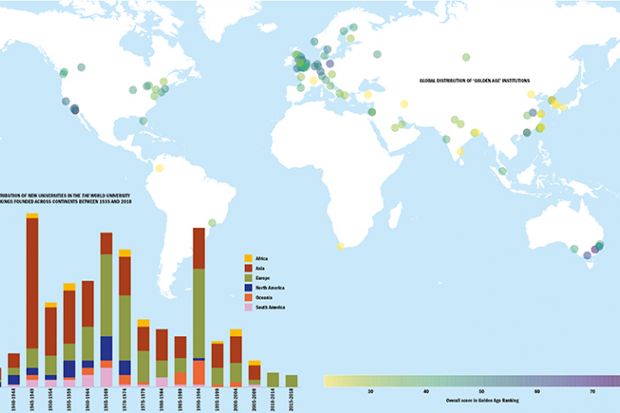Click here to see a large version of the data visualisations
Browse the full list of the top 250 institutions in this year’s rankings
New universities across the globe are founded for many different reasons but one of the key drivers is often government policy and major geo-political events.
This stacked bar chart neatly shows how many institutions in the Times Higher Education World University Rankings 2018 were established in waves in different parts of the world, often in response to such shifts.
Three of these waves in particular stand out. The first comes immediately after the end of the Second World War, with 54 institutions being set up in Asia in the five years spanning 1945 to 1949, a large proportion of them in Japan.
The second occurs in the late 1960s and is led by Europe, which saw 34 new universities set up in the period.
Much of this was driven by a major policy change in the UK that came in the wake of the landmark Robbins report on higher education that recommended a large expansion of the system.
Browse our global database of university jobs
The UK also has a key role in the third wave, which happens in Europe in the early 1990s. Here new legislation allowed dozens of institutions that were polytechnics to become universities; they are now known as post-92 institutions because of the year in which they were formed.
Other notable eras when new universities came on to the scene that have since gone on to be among the best in the world include the early 1970s. France, Germany and Australia stand out here as countries that set up institutions that are now among the highest placed in the Young University Rankings.
Meanwhile, the map above shows how universities in the “Golden Age” ranking – institutions founded more than 50 years ago but less than 80 – are distributed across the world.
The largest concentration is in Europe, again partly reflecting the post-Robbins boom in the UK. But it is also notable that some high-scoring universities can be found in Australia and the US West Coast.
POSTSCRIPT:
Print headline: Growing concerns
Register to continue
Why register?
- Registration is free and only takes a moment
- Once registered, you can read 3 articles a month
- Sign up for our newsletter
Subscribe
Or subscribe for unlimited access to:
- Unlimited access to news, views, insights & reviews
- Digital editions
- Digital access to THE’s university and college rankings analysis
Already registered or a current subscriber?








